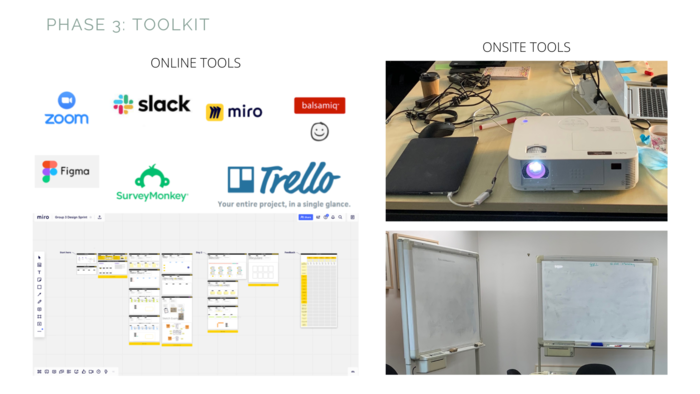
The workshops were a series of four UX Bootcamp sessions organised over a period of four days to generate a rapid understanding of UX methodology. In existence with this new knowledge, the participants developed stamina to stimulate their professional and personal development. UX is a team sport that required extreme focus to contribute to team objectives. As a collective, participants learn new skills within their team environment. Any unfamiliarity in design techniques was paraphrased with clarity so that everyone was thinking on the same level, equipped, and prepared for the job market.

WORKSHOP 1: On the first day the participants were welcomed and made the conscientious effort to follow the schedule planner. The workshop was restricted to 10 people in the room due to the COVID-19 disruption, we were compelled to utilise the online ‘Zoom’ platform so that all thirteen prospects could engage. We faced a few technical glitches en route, and as expected, most first days anticipate teething problems, so we were prepared for the inevitable that reduced as we settled.

WORKSHOP 2: Participants were Introduced to ‘design sprints’ to demonstrate their effectiveness and given resource links for relevant design processes. They had access to up-to-date software implemented during exercises involving a collective of UXers, designers, and software developers. The intent was to provide the ability to adjust to different learning styles. As in terms of their previous knowledge of design software, I was able to evaluate what was missing in their toolkit. By providing participants access to current software tools used in the modern market, they were able to keep abreast of new technology while observing UX principles.

WORKSHOP 3: Participants were introduced to eight popular design frameworks. They were challenged with various scenarios designed to allow friction by undertaking projects at various stages, whether it involved redesigning a project or starting a new one, were good assessments to develop their mind mapping skills. The participants were able to process their objectives relative to conceptual and visual mapping, user personas whilst utilising the whiteboard, where they were able to distinguish what users experience while using an application. These activities developed participants for rapid in-depth learning. They were aware of different frameworks and recognised the relevant framework to solve those problems. Subsequently, they were able to mitigate obstacles with UX design strategies.

WORKSHOP 4: The final workshop was designed to revisit three design frameworks for comparative analysis. This workshop introduced the two most popular frameworks arranged to test the Whistlebox design framework for its efficacy. The descriptive frameworks were Lean UX, Google Design Sprints, and the Whistlebox Design framework. Lean UX and the Google Design Sprint were identified as the most commonly used design frameworks today, The synopsis of each design framework was outlined briefly to assist the participants in their learning for practical focus so that they could execute them within their group environments. As each group nominated a framework to evaluate during a group exercise, the three design frameworks of which to analyse during the research study were revealed at the second part of the workshop when participants converged in their groups to commence their UX environments.

The workshops served as a central hub to enable participants to learn, explore, and evaluate various new technology to engage in challenges for their professional and personal development. The workshops were designed to provide a fun learning environment of one-hour blocks to retain fresh information without repressing interest. Sessions were scheduled over four days, where each day consisted of two hours of learning. Originally weekdays weren’t labeled as ‘Monday to Friday’ but were numbered as ‘Day 1 to Day 4’ to allow for flexibility.

ONSITE TOOLS: A Projector was used to display presentations from computer screens. It involved integration with the ‘Zoom’ online platform. It was considered an onboarding tool to mandate participants with the fundamentals of the UX landscape. Because UX was such a complex landscape to grasp, the projector allowed us to scale presentations on a large wall for clarity. Two whiteboards on site were used to accommodate brainstorming activities which was the UX approach for conceptualising. Whiteboarding validified every group activity articulating their objectives. The whiteboard and the projector apparatus were sought-after commodities because they were highly regarded as design thinking tools.

ONLINE TOOLS: The participants were exposed to current software on the market widely used by organisations around the world. The following software that was used throughout the entire study was updated and used continually. They were made available for the participants to download and use anytime as freeware and opensource.

LEARNING OUTCOMES: The participants required a design thinking mindset to translate their annotations from the workshop to help drive innovation in their designs. This was developed from their rapid training allowing them to improvise and provide viable solutions under pressure.
The following was the accomplished breakdown of professional and personal development:
o Gained user empathy through observation and interviewing and develop user insights to identify user pain points
o Used multiple brainstorming techniques to find innovative solutions
o Prototyped a solution to a user challenge
o Developed and tested the proof of concept to support the viability of the hypothesis.
gLike